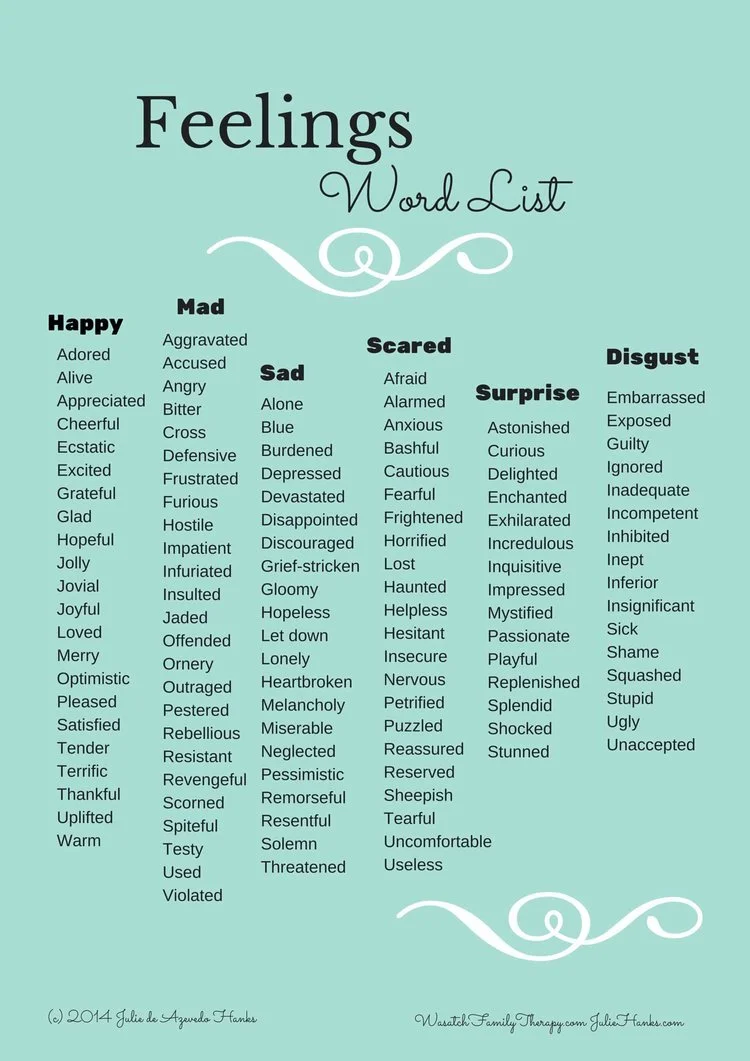Four Steps to Identifying Emotions
"What are you feeling?"
The dreaded therapy question.
Let’s start at the beginning. Although we are always feeling something (yes, always), somehow our education system bypasses emotional literacy in exchange for less useful information. (I don’t know about you, but I have yet to dissect another worm or dust off my knowledge of the pythagorean theorem.)
Emotions are vital because they are little bits of information that alert us to our values, our perception of an experience, our needs, and our likes and dislikes. However, feelings can be challenging and painful, so we ignore them; or perhaps we were discouraged to express them in our childhood, so we suppress them. While this may seem effective in the short-term, suppressed feelings will ultimately find a way out. This can be in the form of mental health concerns (such as anxiety, depression, phobias, etc.) or physical health concerns (such as ulcers, fibromyalgia, gastrointestinal problems, etc.).
It is difficult to manage our emotions and have our needs met if we don't even know what it is that we are feeling in the first place. Here are four steps that will help move you towards a better understanding of your emotions.
FOUR STEPS TO IDENTIFYING EMOTIONS
Note: Emotions and feelings are actually two different things. However, since these words are commonly interchanged in day-to-day language, I will be doing that in this post, as well.
1. What am I feeling?
Hint: "Good," "Fine," and "Okay" are not emotions. Start by taking a few minutes to just sit and notice what you are feeling. See what arises and observe it without judgment. Emotions are neither good nor bad - they just are. Notice what it is that you are feeling without any kind of running commentary on whether you should or should not be feeling that way. If this is a difficult task - and don't worry, it is for many - try using a feelings list to help you identify the emotion. For example: I feel lonely.
2. Where do I feel it?
Notice where it is in your body that you experience this feeling in order to develop a deeper connection to it. Because some emotions can be difficult to experience, our tendency can be to notice it and then distract ourselves from it. This is an opportunity to connect with it further. For example: I feel the loneliness in my chest.
This can also be a helpful starting point if you are struggling to identify the emotion at all. Do a body scan from head to toe and pay attention to any areas in which you might be feeling tightness or tension. What might that body sensation mean? For example, if you notice a lump in your throat, it might be an indication that you are feeling sad. A clenched fist might suggest anger, and having hunched shoulders might indicate stress.
Keep in mind that we can feel more than one emotion at a time. We can feel both relieved and sad upon quitting a job, or both scared and excited by an upcoming challenge.
3. Why am I feeling it?
Emotions are sneaky in that they are not necessarily rational. We might have an emotional response that directly relates to the present moment or it might be a trigger from a past experience. The feeling might also be based on your perception of a person or situation. If you perceive someone to be rude, then you might feel angry towards them.
Continue to just sit with the experience and see if you can follow the bread crumb trail to what happened to elicit this emotional response. For example: I feel lonely because all my friends had plans for tonight and now I am home alone.
Our emotions are also influenced by our thoughts, so paying attention to what we are thinking can also provide a clue as to why we are feeling a certain way. For example: I told myself today would be an awful day and now I feel hopeless.
If you can't figure it out, don't worry. Even if it is not entirely in your consciousness, it does not change the fact that what you are feeling is both valid and relevant. Just continue to observe it without judgement.
4. What do I need?
Stay with the emotion(s), notice where you feel it, explore why it is there, and determine what would help in that given moment. For example: I need to practice self-compassion and work on planning ahead of time.
Here's the catch - you have to feel the difficult feelings in order to fully address them. We look for shortcuts through distractions, achievements, and people; however, we are the only ones who can control our emotions. So be patient with yourself and acknowledge that emotional literacy takes ongoing practice. The more you can name your feelings, the more you can respond rather than react.
This sounds awful. Why would I feel my feelings?
Yes, it can feel awful for a while. However, when we release emotions, we also release the hold we think they have on us. We can resolve past hurts, improve our relationships, and live life more fully.
By delaying the process of dealing with our emotions, we may search outside of ourselves for ways to numb the pain and feel better. We might even fall into the trap of believing that we will be happy "when."
"I can relax when I have my credit card paid off."
"I'll feel safe when I have a loving partner."
"I'll be confident when I lose that weight."
Unfortunately, we will still feel stressed, afraid, and insecure, no matter what the external circumstances are since our feelings just come along with us. We continue to seek out the next thing that will "make us feel better" (which might work for a short period of time) before we repeat the cycle all over again.
The only way out is through, which is what makes experiencing our feelings so painful (and avoiding them so tempting). But all emotional experiences, both good and bad, are temporary and will pass. It can absolutely feel daunting to ride theses waves of emotions, which is where a good support system, self-compassion, and a therapist can come in handy.



